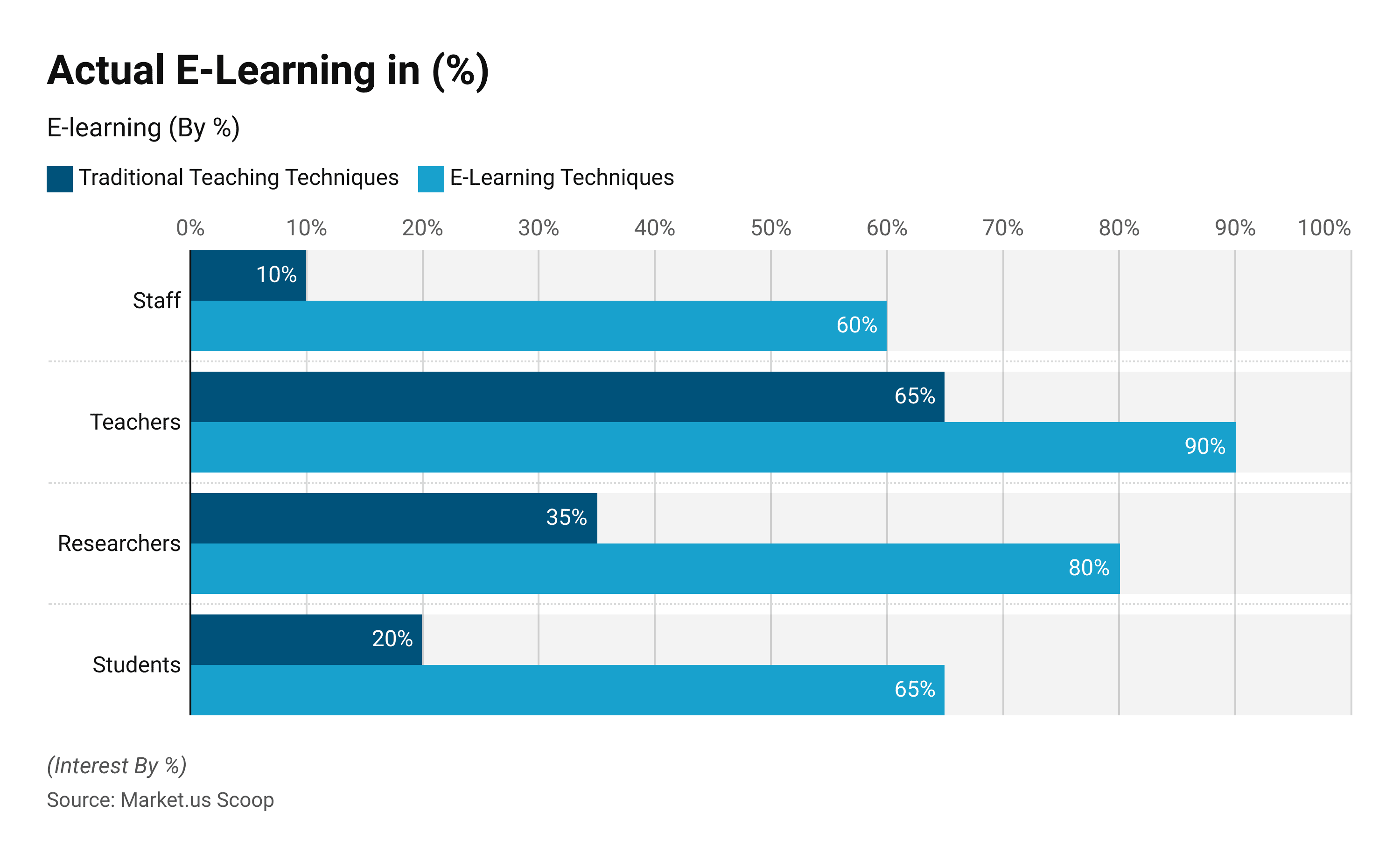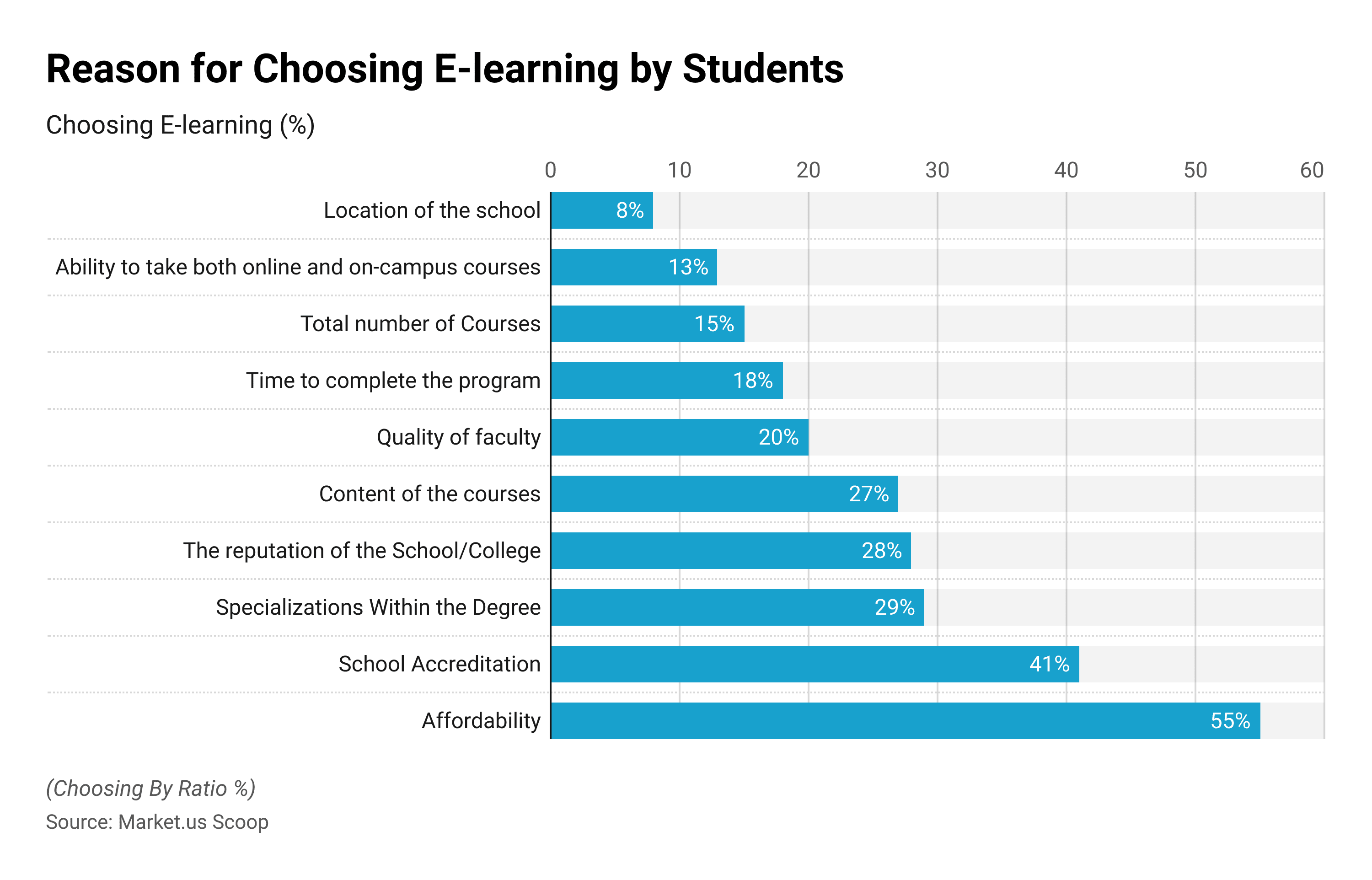Table of Contents
- Top 2023 eLearning Statistics
- What’s New in 2023?
- E-learning Statistics Globally
- E-learning Statistics on Business
- E-learning Statistics for Academics
- elearning in Higher Education
- Facts About elearning Platforms
- More Interesting Facts About eLearning
- Course Selection and Enrolment Statistics
- Online Course and MOOC Statistics
- Major notable changes
- The challenges of eLearning
- Leading eLearning Platforms by Market Share
- Best eLearning Apps in 2022
According to eLearning Statistics, 58% of employees prefer self-paced online learning. This shows that many employees take eLearning courses during their free time, after work, or on weekends.
Top 2023 eLearning Statistics
- The global eLearning market is expected to reach 350 billion dollars by 2025. It is projected to grow by 20% between 2022 and 2028.
- 73% of US students want to continue their online classes after the pandemic.
- 90% of companies offer their employees some type of digital training.
- 68 % of employees prefer learning on the job.
- Coursera has seen a 438% increase in users over the last five years.
- By 2027, it is estimated that the number of online learners will reach 57,000,000.
What’s New in 2023?
In recent years, online learning has grown in popularity due to technological advances and modernization. Here are the latest statistics on online learning, and how it affects global education.

E-learning Statistics Globally
70% of eLearning traffic is generated in the US and Europe.
Learning and observing are 60% faster in e-learning than in physical classes. E-learning is digestible and can cover a large amount of material in a short time.
(Source: Skill Scouter, Papers Owl)
E-learning Statistics on Business
- 93% of global companies switch to online learning because it is convenient and easy to implement during pandemics. Even if the company does not switch to online education, it will still use it in lieu.
- Online learning is preferred by 58% of employees. Many employees are taking eLearning courses in their spare time, after working hours, or at weekends.
(Sources: Finances online, NCES)
E-learning Statistics for Academics
- 50% of the students who follow academic curricula in 2021 will be using eLearning. The majority of schools have already started integrating eLearning into their curriculum.
- 40% of students believe that eLearning modules are easier to understand and more effective than classroom instruction.
(Source: Skill Scouter, Statista)
Take advantage of our unbeatable offer - buy now!

elearning in Higher Education
eLearning is gaining popularity in the world of higher learning. Students in post-secondary education tend to be interdependent. Some students work full-time, while others only part-time. The role of parents with children is also important. Students find eLearning more convenient than traditional methods like chalk and a board because it can be done at their own pace.

Facts About elearning Platforms
- The user penetration of online learning platforms will be 11.6% by 2023, and 16.6% by 2027.
- Revenue from online learning platforms will reach $2.85 Billion by 2023.
- Udemy is the leading online learning platform with a database of over 10 million students. Udemy produces high-quality material in many niches and categories.
- The e-learning market on MOOCs could reach $25.55 billion over the next few years and cover the path to a whole new era of online learning.
(Source: Skill Scouter, Tech Jury)
More Interesting Facts About eLearning
- 77% of academic leaders rated online education as having the same or better learning outcomes than face-to-face courses.
- 60% of online learners are employed full-time. In the mobile learning sector, 52% of users use mobile learning in bed when they first wake up. And 46% of people use it just before bedtime.
- Graduates who earn between $85,001 and $150,001 per year make up 29% of all online graduates.
- Students studying online business make up 33% of the total.
- BBC research from 2003 showed that micro-learning modules can improve retention by 30%.
- Over 80% have credits they can use to meet their degree requirements.
Course Selection and Enrolment Statistics
- “Specific field of study “is a leading factor in online college selection for students in the United States.
Online Course and MOOC Statistics
Massive Open Online Learning is now offered by most learning institutions. The majority of MOOCs online are offered for free, making them a fantastic way to educate both students and teachers.
Massive Open Source Courses (MOOCs), which provide professional education and quality content, are also increasing in popularity.
- The MOOC market was worth 5.16 billion in 2019.MOOC is expecting a 29% growth per year on the market in 2020-2025.
- North America accounts for 29.4% of the global MOOC Market. Online classes are offered by 22 out of the top 25 American universities. In the years 2020-2025, MOOCs in the Asia-Pacific region will be the fastest-growing market.
- 73% of students do not know what MOOCs are.
- MOOCs will have a share of the market estimated at $21.4 billion in 2025.
Major notable changes
- Coursera has the potential to increase the number of learners from 45 million in 2020 to 76 million.
- Edx is able to improve the learning experience of 24 million students, bringing it up to 35 million. This is a substantial improvement.
- Future Learn is offering 23 degrees this year and 28 in 2020.
The challenges of eLearning
- Physical learning is harder than one-on-one training. Online learning is not any easier.
- Students struggle to adapt, as the traditional classroom setting was their only learning method.
- In this industry, technical issues are common because these platforms rely entirely on technology.
In order to facilitate online learning, the infrastructure was required. The number of online platforms has increased. These platforms offer learners, trainers, and other stakeholders the tools and services they need for online education.
They also help with managing learning resources, delivering them, and even creating a business model.
- Udemy has over 50,000 tutors and 40,000,000 students.
- edX: This online learning platform has partnered up with other learning institutions to offer more than 8,004 online courses.
- Skillshare: This platform has around four million users, and approximately 24000 courses.
- Coursera has 23,000,000 users and is partnered with other educational institutions.
- Learn from LinkedIn: There are over 16,000 classes in seven different languages and two subscription options. The monthly fee is $29.99 and the annual fee is $239.88.
Best eLearning Apps in 2022
- BYJU’s Learning
- Udemy
- Khan Academy
- edX
- Coursera
- Duolingo
- SoloLearn
- Skillshare
- LightBot
Discuss your needs with our analyst
Please share your requirements with more details so our analyst can check if they can solve your problem(s)



